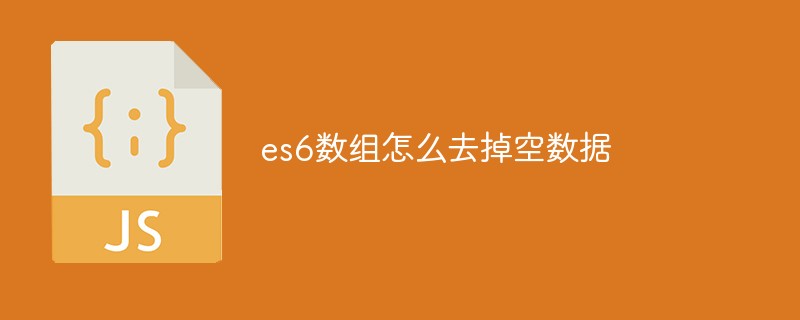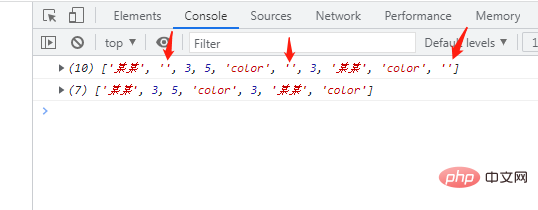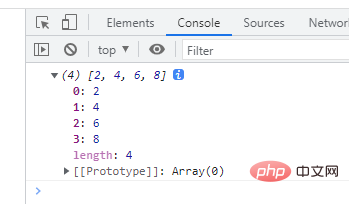How to remove empty data from es6 array
Two methods: 1. Use for to find the element with an empty value, and use splice() to delete it. The syntax is "for(i=0;i

The operating environment of this tutorial: Windows 7 system, ECMAScript version 6, Dell G3 computer.
Two methods to remove empty data from es6 array
Method 1: Use for loop and splice() function
Use a for loop to traverse the array
Find the element with an empty value in the loop body
According to the index of the element, use the splice() function to remove the element
Implementation code:
//数组去空值
var arr1=["某某","",3,5,"color","",3,"某某","color",""]
console.log(arr1)
//拓展数组去空值的方法
Array.prototype.removeEmpty=function () {
for(var i=0;i<this.length;i++){
if(this[i]==""||typeof(this[i])=="undefind"){
this.splice(i,1);
i--;
}
}
return this;
}
var arr2=arr1.removeEmpty();
Method 2: Use the filter() function to filter the array and return non-empty elements
filter() function will call a callback function to filter the array elements and return all elements that meet the conditions (create a new array to return)
You only need to set the qualifying condition to "not empty data"
How to write the function to set the filter condition
function f(value){
return (value);
}Use the filter() function to call a callback function f(value) to filter the array.
Implementation code:
//数组去空值
function f(v){
return (v);
}
var arr1=["某某","",3,5,"color","",3,"某某","color",""]
console.log(arr1)
var arr2=arr1.filter(f);
console.log(arr2)
Description: filter() method
filter() method Creates a new array whose elements are checked by checking all elements in the specified array that meet the criteria.
Function: You can return the elements in the array that meet the specified conditions.
array.filter(function callbackfn(Value,index,array),thisValue)
function callbackfn(Value,index,array): A callback function, which cannot be omitted. It can accept up to three parameters:
value: The value of the current array element, cannot be omitted.
index: The numeric index of the current array element.
array: The array object to which the current element belongs.
The return value is a new array containing all the values for which the callback function returns true. If the callback function returns false for all elements of array , the length of the new array is 0.
Let’s learn more about it through an example: Return all even numbers
var a = [2,3,4,5,6,7,8];
function f (value) {
if (value % 2 == 0) {
return true;
}else{
return false;
}
}
var b = a.filter(f);
console.log(b);Output result:

[Related recommendations: javascript Video tutorial、Programming video】
The above is the detailed content of How to remove empty data from es6 array. For more information, please follow other related articles on the PHP Chinese website!

Hot AI Tools

Undresser.AI Undress
AI-powered app for creating realistic nude photos

AI Clothes Remover
Online AI tool for removing clothes from photos.

Undress AI Tool
Undress images for free

Clothoff.io
AI clothes remover

Video Face Swap
Swap faces in any video effortlessly with our completely free AI face swap tool!

Hot Article

Hot Tools

Notepad++7.3.1
Easy-to-use and free code editor

SublimeText3 Chinese version
Chinese version, very easy to use

Zend Studio 13.0.1
Powerful PHP integrated development environment

Dreamweaver CS6
Visual web development tools

SublimeText3 Mac version
God-level code editing software (SublimeText3)

Hot Topics
 1387
1387
 52
52
 How to implement an online speech recognition system using WebSocket and JavaScript
Dec 17, 2023 pm 02:54 PM
How to implement an online speech recognition system using WebSocket and JavaScript
Dec 17, 2023 pm 02:54 PM
How to use WebSocket and JavaScript to implement an online speech recognition system Introduction: With the continuous development of technology, speech recognition technology has become an important part of the field of artificial intelligence. The online speech recognition system based on WebSocket and JavaScript has the characteristics of low latency, real-time and cross-platform, and has become a widely used solution. This article will introduce how to use WebSocket and JavaScript to implement an online speech recognition system.
 WebSocket and JavaScript: key technologies for implementing real-time monitoring systems
Dec 17, 2023 pm 05:30 PM
WebSocket and JavaScript: key technologies for implementing real-time monitoring systems
Dec 17, 2023 pm 05:30 PM
WebSocket and JavaScript: Key technologies for realizing real-time monitoring systems Introduction: With the rapid development of Internet technology, real-time monitoring systems have been widely used in various fields. One of the key technologies to achieve real-time monitoring is the combination of WebSocket and JavaScript. This article will introduce the application of WebSocket and JavaScript in real-time monitoring systems, give code examples, and explain their implementation principles in detail. 1. WebSocket technology
 How to use JavaScript and WebSocket to implement a real-time online ordering system
Dec 17, 2023 pm 12:09 PM
How to use JavaScript and WebSocket to implement a real-time online ordering system
Dec 17, 2023 pm 12:09 PM
Introduction to how to use JavaScript and WebSocket to implement a real-time online ordering system: With the popularity of the Internet and the advancement of technology, more and more restaurants have begun to provide online ordering services. In order to implement a real-time online ordering system, we can use JavaScript and WebSocket technology. WebSocket is a full-duplex communication protocol based on the TCP protocol, which can realize real-time two-way communication between the client and the server. In the real-time online ordering system, when the user selects dishes and places an order
 How to implement an online reservation system using WebSocket and JavaScript
Dec 17, 2023 am 09:39 AM
How to implement an online reservation system using WebSocket and JavaScript
Dec 17, 2023 am 09:39 AM
How to use WebSocket and JavaScript to implement an online reservation system. In today's digital era, more and more businesses and services need to provide online reservation functions. It is crucial to implement an efficient and real-time online reservation system. This article will introduce how to use WebSocket and JavaScript to implement an online reservation system, and provide specific code examples. 1. What is WebSocket? WebSocket is a full-duplex method on a single TCP connection.
 JavaScript and WebSocket: Building an efficient real-time weather forecasting system
Dec 17, 2023 pm 05:13 PM
JavaScript and WebSocket: Building an efficient real-time weather forecasting system
Dec 17, 2023 pm 05:13 PM
JavaScript and WebSocket: Building an efficient real-time weather forecast system Introduction: Today, the accuracy of weather forecasts is of great significance to daily life and decision-making. As technology develops, we can provide more accurate and reliable weather forecasts by obtaining weather data in real time. In this article, we will learn how to use JavaScript and WebSocket technology to build an efficient real-time weather forecast system. This article will demonstrate the implementation process through specific code examples. We
 Simple JavaScript Tutorial: How to Get HTTP Status Code
Jan 05, 2024 pm 06:08 PM
Simple JavaScript Tutorial: How to Get HTTP Status Code
Jan 05, 2024 pm 06:08 PM
JavaScript tutorial: How to get HTTP status code, specific code examples are required. Preface: In web development, data interaction with the server is often involved. When communicating with the server, we often need to obtain the returned HTTP status code to determine whether the operation is successful, and perform corresponding processing based on different status codes. This article will teach you how to use JavaScript to obtain HTTP status codes and provide some practical code examples. Using XMLHttpRequest
 How to use insertBefore in javascript
Nov 24, 2023 am 11:56 AM
How to use insertBefore in javascript
Nov 24, 2023 am 11:56 AM
Usage: In JavaScript, the insertBefore() method is used to insert a new node in the DOM tree. This method requires two parameters: the new node to be inserted and the reference node (that is, the node where the new node will be inserted).
 JavaScript and WebSocket: Building an efficient real-time image processing system
Dec 17, 2023 am 08:41 AM
JavaScript and WebSocket: Building an efficient real-time image processing system
Dec 17, 2023 am 08:41 AM
JavaScript is a programming language widely used in web development, while WebSocket is a network protocol used for real-time communication. Combining the powerful functions of the two, we can create an efficient real-time image processing system. This article will introduce how to implement this system using JavaScript and WebSocket, and provide specific code examples. First, we need to clarify the requirements and goals of the real-time image processing system. Suppose we have a camera device that can collect real-time image data




